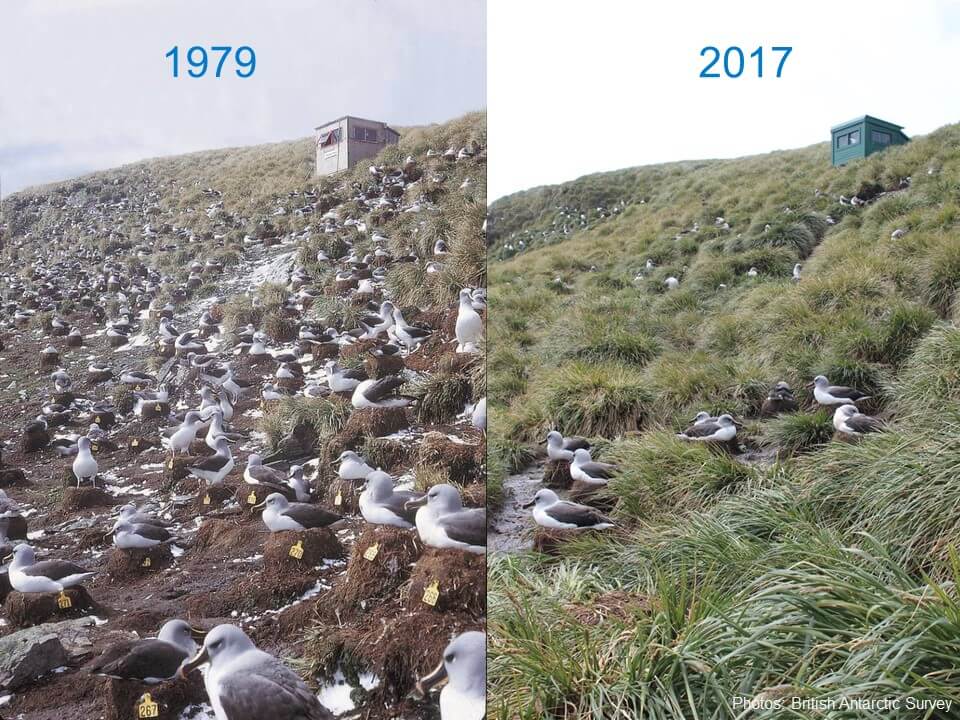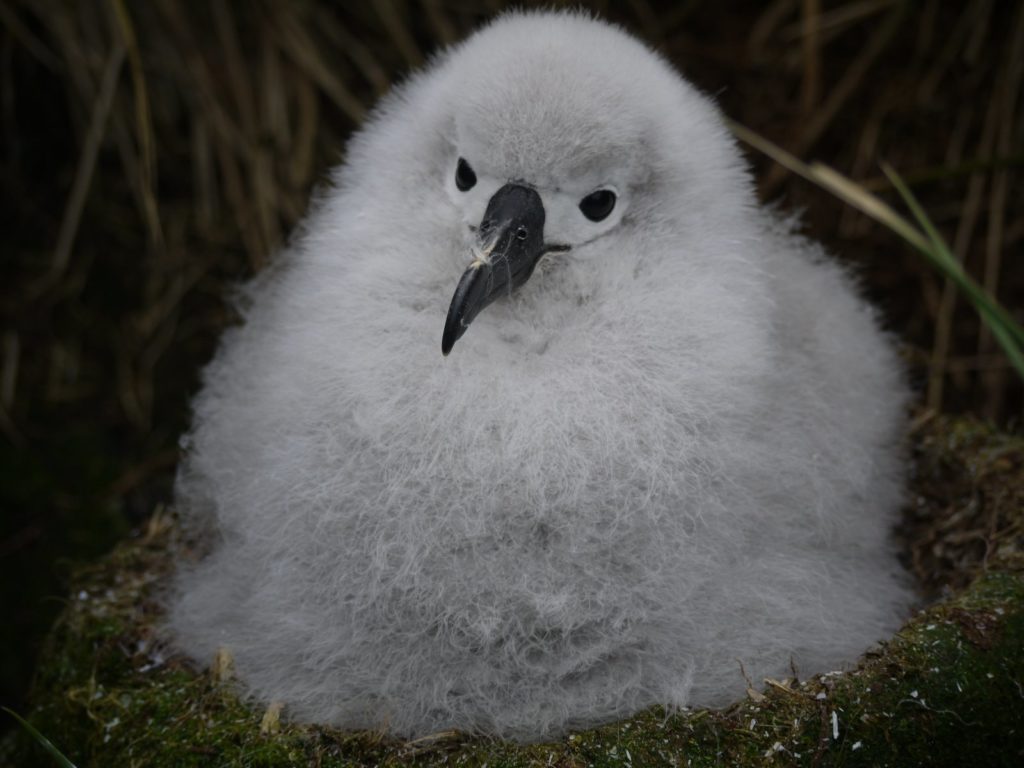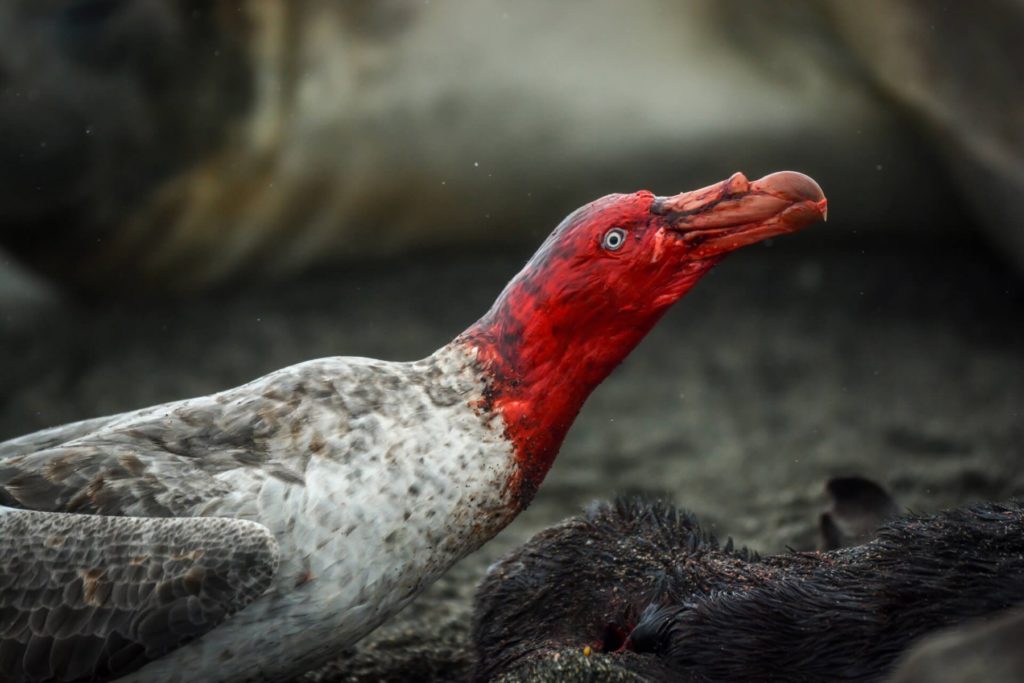Too many youngsters were going missing after fledging. With no knowledge of where they fly to, it was much harder to halt their decline. Grey-headed Albatross numbers are dropping by 5% a year on South Georgia. Now, nine satellite-tagged juveniles have successfully left the nest. We can watch their journey – and so can you.
Follow the albatrosses’ journey on this live map.
A single egg sits nestled between swaying tussock grass on a windswept, sub-Antarctic island. The parents incubate the egg for 72 days, alternating shifts. It hatches, exploding into a gigantic cotton wool ball of a chick. Its parents dote on it, providing more than half a kilogram of food a day, and it matures into a sleek, dapper fledgling.
And then it disappears.
This is the problem that has confounded British Antarctic Survey (BAS) researchers on South Georgia, a remote British Overseas Territory in the middle of the South Atlantic. We’re all familiar with the tradition of youngsters taking a gap year to explore the world and find themselves, but juvenile Grey-headed Albatrosses Thalassarche chrysostoma take this rite of passage to the extreme. When they fledge, they rove across the Southern Ocean, plucking food from the sea. We don’t know exactly where they go, but we do know that it’s a different range to the adults. And then, after around seven years, they return to their colony of hatching to breed. Or, at least, they used to.
It’s a problem that needs to be solved fast, because the Grey-headed Albatross is in crisis. The reason for its Endangered status: a catastrophic population decline at South Georgia, its largest breeding stronghold. Since 1977, numbers have more than halved, and over the last decade the decline has accelerated to a worrying 5% a year – far faster than any other albatross species. The difference on the islands is stark – colonies that once teemed with nests and chicks are now sparse and lacklustre, with bare stretches of tussock grass swaying in the wind.

Richard Phillips, BAS seabird researcher, explains: “We’ve been intensively monitoring albatrosses on Bird Island for over 40 years, and from recording re-sightings of ringed birds, we worked out that survival rates in the first few years after leaving the colony were far lower than expected, which was a major contributor to the population decline. However, we had little idea of what was happening to the birds before they returned.” Their only lead was a handful of reports from Japanese longline fishing vessels. “Japanese fisheries were reporting Grey-headed Albatross juveniles as bycatch,” Says Stephanie Winnard, International Marine Project Officer for the RSPB (BirdLife in the UK). “But there was some confusion over whether they were being wrongly identified, as they are notoriously hard to distinguish from juveniles of other species.” There was only one way to know for sure.
And so in May 2018, 16 satellite tags were attached to albatross chicks on the aptly-named Bird Island, in collaboration with BirdLife International’s Global Seabird Programme*. Field Scientist Derren Fox recalls the ease of tagging a bird that has evolved with no natural mammalian predators: “Tagging was very straightforward. It took in the region of 4-5 minutes for each bird, and we selected healthy, well-developed chicks to increase the chances of them fledging successfully and surviving as long as possible.”

Then, in early June, the moment they had all been waiting for arrived. One by one, the albatrosses set off on their maiden voyages – and the team watched with baited breath to see what happened next. “It is a real privilege to watch the chicks fledge,” says Derren. “You can’t help but get attached to them, visiting some of the colonies so frequently, especially as towards the end of the season they suffer so much predation within the colonies.”
The predation that Derren refers to is the threat of giant petrels and skuas, which attack the naïve fledglings. And this threat is only getting worse. In a vicious circle, the sparsity of Grey-headed Albatrosses on South Georgia is allowing giant petrel attacks to become more and more successful. Tragically, seven of the 16 tagged juveniles never made it off the island for this reason.

Fortunately, nine intrepid explorers have escaped unscathed, and their route is already beginning to engross the team. “Initial results have shown some of the juveniles headed to the area where they were reported to have been killed by the Japanese fishery, which is the first time we’ve tracked the species to that area,” says Steph. This ties in with recent research by the RSPB and BAS, which showed high overlap between Grey-headed Albatrosses from South Georgia and the extensive tuna fisheries of Japan and Chinese Taiwan.
Once this has been confirmed, the Global Seabird Programme can get to work. “We had already been engaging with the fishing agencies of Japan and Chinese Taiwan, as well as directly with some of the fishermen themselves,” says Steph. “Now we can ensure this work is even better targeted to try and ensure that these incredible voyagers can get home safely”.
The juvenile Grey-headed Albatrosses are being tracked in near real-time using the Argos system, and a map of their movements can be seen at the project web page.
*Funding for the devices used this season was obtained from the David and Lucile Packard Foundation, through the BirdLife International Global Seabird Programme.
Funding for devices to continue this project in 2019 is being provided by the South Georgia Heritage Trust.